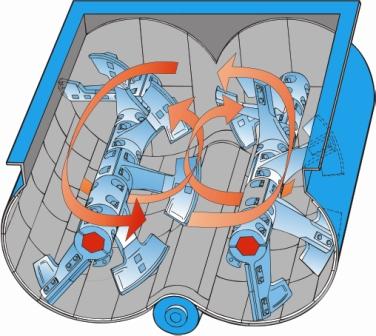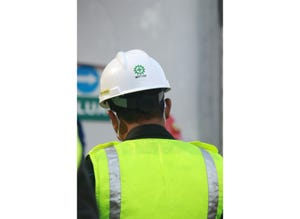The Benefits of Twin-Shaft Mixing
June 6, 2012

Everyone has a general idea what mixing means, but describing the mixing process is not so simple. The objective of any mixing process is to distribute and blend the materials with different characteristics, different quantities as evenly as possible resulting in a homogenous mixture.
Introducing proportional movement with the optimal intensity into the materials achieves effective homogeneous mixing results. A simple one-directional movement with inadequate acceleration of the materials would obviously not achieve the same mixing results. This would be more like stirring than mixing.
The amount of relative movement that is introduced is a decisive factor. Circumstances for successful mixing involve distribution of all materials, and achieving the highest probability that all recipe particles located in a specific position at the beginning can be found at any random location in the mixing chamber at the end of the process. This is the only way to ensure that a consistent result is achieved every time mixing is repeated.
Three-Part Cycle
The mixing cycle occurs in three phases: charging the mixer, the mixing process, and discharging. The sequence in which the individual materials to be mixed are filled into the mixer can have a huge impact on the efficiency of the mixing cycle. The mixing cycle overlaps the charging process and the discharge cycle follows the mixing cycle. To achieve optimum results, effective discharging methods should be taken into consideration to avoid risks of segregation. Costs for energy and wear should be as low as possible. Finally, it is important that the mixing cycle takes place as quickly as possible.
In concrete production, selecting the best mixing technology is crucial for both the quality of the concrete produced and the efficiency of the production process. The optimum mixing system is one that rapidly disperses all ingredients evenly throughout the mixing trough and completely surrounds all the aggregate particles with the slurry cement particles. Most concrete formulas also involve small quantities of chemical additives which also must be evenly distributed effectively. The time required per mixing cycle as well as the costs of energy, wear, and maintenance will determine the economy of the concrete production.
Twin-Shaft Technology
The twin-shaft batch mixer has become a preferred technology for concrete production in many countries. The twin-shaft mixer for concrete production was invented at the end of the 19th century and registered for patent by BHS-Sonthofen in Germany. The initial reasoning was to replace manual mixing with a shovel in which a line of aggregate, cement, and water positioned on the ground, was repeatedly shoveled from right to left. This concept was later abandoned and over a number of development stages, was replaced by today’s highly dynamic movement process.
Today’s twin-shaft mixers are equipped with mixing blades on both mixing shafts that are geometrically arranged so they follow the pattern of an interrupted spiral. This motions the materials to be mixed in a screw-like pattern both along the mixing shafts and on each shaft in opposite directions. On the ends of both shafts the mixing blades are positioned in a counter direction so they can transport the mix onto the opposing shaft. This way, the materials are constantly rotating around the mixing trough. At the same time, the material rotating process also takes place in an inward turning spiral. This results in an intensive three-dimensional movement of material.
Intense Mixing
The two mixing circuits (see figures 1&2) overlap in the middle to further increase the intensity of the relative motion. This creates a high turbulent zone in the middle of the mixing trough and intensifies the mixing process. It is possible to achieve 95% homogeneity with only 30 seconds of mixing time (see figure 3). This can be achieved with a relatively low mixing speed of the shafts, between 20 to 30 rpm. This low mixing speed reduces energy consumption, reduces wear, and avoids stress on the particles to be mixed.
Cement is the most important and most costly raw material in concrete production, typically 10% of the mix design and 90% of the cost. Only an excellent mixer can guarantee the most efficient use of this high-value raw material. Various tests have shown that a twin-shaft batch mixer can produce concrete of a given strength with less cement then other mixing methods and types.
The twin-shaft mixer discharging process is accomplished along the center of the mixer between both mixing shafts using a rotary gate that is the length of the mixing trough. A major portion of the mixed materials are discharged through the opening created by gravity. The remainder of the materials is forced out by the broad mixing blades with almost no residue remaining. The risk of mix segregation is therefore extremely low. The rotary discharge gate system is also equipped with adjustable opening positions that increase or decrease the outflow during discharge. Additionally, the rotary gate system is equipped with internal adjustable ledges for sealing. This design also allows the door to be closed without the risk of particles preventing the door from closing.
The twin-shaft batch mixer is also characterized by its relatively high filling level compared to other concrete mixing systems. The benefit, is that the mixing trough can be built much more compact which simplifies retrofits and replacements of other types of mixers. Further, due to the smaller mixing area, the twin-shaft has less wear then other mixing systems which allow only limited filling levels.
A comparison with other mixing systems also shows advantages towards drive power and reduced energy consumption. Due to the rapid mixing time, the twin-shaft utilizes less power per batch.
Different Applications
The twin-shaft mixer is also an important solution for unique operational requirements. For example, ice for cooling the concrete and or steam for heating is possible. A twin-shaft mixer can also accommodate small batches, expecting the same mixing performance and results. Concrete formulas with course aggregate sizes up to 7 in. can be processed. Scientific studies have confirmed that self-consolidating concrete (SCC) can also be processed within the same 30-sec mix time (Figure 3).
The principle advantages of the twin-shaft mixing technology become even more evident with larger mixing batch size and larger machine capacity. This places different demands on the mixing machine. The twin-shaft batch mixer is guaranteed to achieve the same mixing results within the same mixing time, regardless of the size of the mixer. This results from the precise upsize design of the mixing tools. In addition, the operating costs are reduced per cubic yard as the mixer becomes larger. The numerous advantages of the twin-shaft mixer demonstrate that it is ideal for producing standard concrete recipes, as well as special mixes for RCC, SCC, and UHPC.
In summary, for concrete production that requires uniform homogeneous consistency at rapid mixing rates with reduced operational costs, the twin-shaft mixer is an ideal solution.
Stuart Bentley is mixing division manager for the U.S. Division of BHS-Sonthofen (Charlotte, NC). For more information, call 704-814-7671 or visit www.bhs-sonthofen.com.
You May Also Like


